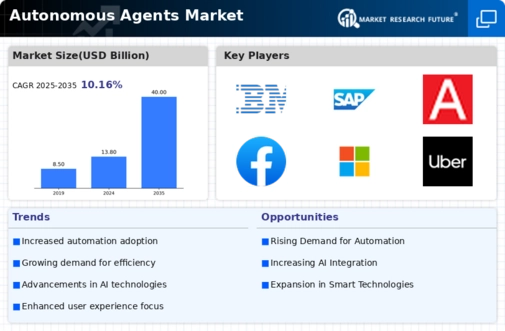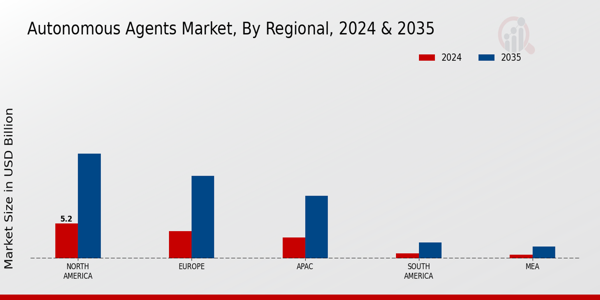Market Growth Projections
The Global Autonomous Agents Market Industry is poised for substantial growth, with projections indicating a market value of 13.8 USD Billion in 2024 and an anticipated rise to 40 USD Billion by 2035. This growth trajectory suggests a robust compound annual growth rate of 10.17% from 2025 to 2035. Such projections reflect the increasing integration of autonomous agents across various sectors, driven by advancements in technology and rising demand for automation. As industries continue to explore the potential of these agents, the market is likely to witness significant developments and innovations in the coming years.
Technological Advancements
Technological advancements play a pivotal role in shaping the Global Autonomous Agents Market Industry. Innovations in artificial intelligence, machine learning, and robotics are driving the development of more sophisticated autonomous agents. These technologies enable agents to perform complex tasks with greater accuracy and efficiency. For example, advancements in natural language processing allow virtual assistants to understand and respond to human queries more effectively. As these technologies continue to evolve, they are likely to enhance the capabilities of autonomous agents, thereby expanding their applications across various industries and contributing to the market's overall growth.
Growing Consumer Acceptance
Consumer acceptance of autonomous agents is steadily increasing, significantly impacting the Global Autonomous Agents Market Industry. As individuals become more familiar with technologies like smart home devices and virtual assistants, their willingness to embrace autonomous agents in daily life grows. This shift in consumer behavior is evidenced by the rising sales of smart speakers and home automation systems. Furthermore, as consumers recognize the benefits of convenience and efficiency offered by these agents, the demand for their integration into various applications is likely to rise, further driving market expansion.
Rising Demand for Automation
The Global Autonomous Agents Market Industry experiences a surge in demand for automation across various sectors, including manufacturing, logistics, and customer service. As organizations strive to enhance efficiency and reduce operational costs, autonomous agents emerge as a viable solution. For instance, in logistics, companies are increasingly deploying autonomous delivery drones and robots, which streamline operations and improve delivery times. This trend is expected to contribute to the market's growth, with projections indicating a market value of 13.8 USD Billion in 2024 and a potential increase to 40 USD Billion by 2035, reflecting a compound annual growth rate of 10.17% from 2025 to 2035.
Regulatory Support and Frameworks
Regulatory support and frameworks are emerging as vital components influencing the Global Autonomous Agents Market Industry. Governments worldwide are recognizing the potential of autonomous agents and are establishing guidelines to facilitate their safe deployment. For example, regulatory bodies are developing standards for the use of autonomous vehicles and drones, ensuring safety and compliance. This proactive approach not only fosters innovation but also instills confidence among businesses and consumers regarding the use of autonomous agents. As regulatory frameworks become more defined, they are expected to encourage investment and adoption, thereby contributing to the market's growth.
Increased Investment in Research and Development
Investment in research and development is a crucial driver for the Global Autonomous Agents Market Industry. Governments and private enterprises are allocating substantial resources to explore the potential of autonomous agents. This investment fosters innovation and accelerates the development of new applications. For instance, various countries are funding initiatives aimed at integrating autonomous agents into public services, such as healthcare and transportation. The emphasis on R&D not only enhances the functionality of these agents but also promotes their adoption across diverse sectors, thereby propelling market growth and ensuring a competitive landscape.

























Leave a Comment